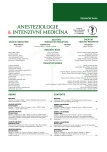Administration of 500 ml of normal saline does not result in immediate damage to the endothelial glycocalyx determinable by sublingual microcirculation assessment
Authors:
J. Pouska 1,2; D. Astapenko 3,4; V. Tégl 1,2,5; J. Beneš 1,2,5; V. Černý 3,4,6-9
Authors‘ workplace:
Klinika anesteziologie, resuscitace a intenzivní medicíny, Fakultní nemocnice Plzeň
1; Klinika anesteziologie, resuscitace a intenzivní medicíny, Lékařská fakulta v Plzni, Univerzita Karlova
2; Klinika anesteziologie, resuscitace a intenzivní medicíny, Fakultní nemocnice Hradec Králové
3; Lékařská fakulta v Hradci Králové, Univerzita Karlova
4; Biomedicínské centrum, Lékařská fakulta v Plzni, Univerzita Karlova
5; Klinika anesteziologie, perioperační a intenzivní medicíny, Univerzita J. E. Purkyně, Masarykova nemocnice, Ústí nad Labem
6; Institut postgraduálního vzdělávání ve zdravotnictví
7; Centrum pro výzkum a vývoj, Fakultní nemocnice Hradec Králové
8; Dept. of Anesthesia, Pain Management and Perioperative Medicine, Dalhousie University, Halifax, Kanada
9
Published in:
Anest. intenziv. Med., 29, 2018, č. 6, s. 322-327
Category:
Overview
Objective:
Assessment of endothelial glycocalyx alteration after infusion of 500 ml of normal saline by perfused boundary region (PBR) parameter in twelve healthy volunteers.
Hypothesis:
Endothelial glycocalyx will be significantly altered by infusion of 500 ml of normal saline.
Design:
Non-randomized, prospective, double-centre study.
Settings:
Two ICUs in University Hospitals.
Materials and methods:
Twelve healthy volunteers without acute illness were recruited. 500 ml of normal saline was infused to each participant. We collected basic haemodynamic data as well as perfused boundary region as a marker of endothelial glycocalyx integrity before and after the fluid administration. Student T-test (paired) with p-value of 0.05 was used for the statistical analysis.
Results:
After administration of 500 ml of normal saline there was non-significant change in PBR (2.00±0.21 vs. 2.21±0.36, p = 0.089). Concerning the macrohaemodynamics, there was a significant drop in the heart rate after the infusion (74±10 vs. 68±10, p = 0.003).
Conclusion:
Our study did not confirm alteration of the endothelial glycocalyx after intravenous administration of 500 ml of normal saline to healthy volunteers. There was a significant decrease of heart rate after the infusion but no other changes were observed.
keywords
microcirculation – intravenous infusion – endothelial glycocalyx
Sources
1. Jacob M, Chappell D. Reappraising Starling: The physiology of the microcirculation. Curr Opin Crit Care. 2013;19 : 282–289. doi:10.1097/MCC.0b013e3283632d5e.
2. Cerny V, Astapenko D, Brettner F, et al. Targeting the endothelial glycocalyx in acute critical illness as a challenge for clinical and laboratory medicine. Crit Rev Clin Lab Sci. 2017;54 : 343–357. doi:10.1080/10408363.2017.1379943.
3. Murphy LS, Wickersham N, McNeil JB, et al. Endothelial glycocalyx degradation is more severe in patients with non-pulmonary sepsis compared to pulmonary sepsis and associates with risk of ARDS and other organ dysfunction. Ann Intensive Care. 2017;7 : 102. doi:10.1186/s13613-017-0325-y.
4. Vincent JL, Weil MH. Fluid challenge revisited. Crit Care Med. 2006;34 : 1333–1337. doi:10.1097/01.CCM.0000214677.76535.A5.
5. Oberleithner H, Peters W, Kusche-Vihrog K, et al. Salt overload damages the glycocalyx sodium barrier of vascular endothelium. Pflugers Arch Eur J Physiol. 2011;462 : 519–528. doi:10.1007/s00424-011-0999-1.
6. Chappell D, Bruegger D, Potzel J, et al. Hypervolemia increases release of atrial natriuretic peptide and shedding of the endothelial glycocalyx. Crit Care. 2014;18 : 1–8. doi:10.1186/s13054-014-0538-5.
7. Cerny V, Astapenko D, Burkovskiy I, et al. Glycocalyx in vivo measurement. Jünger M, Krüger-Genge A, Jung F, eds. Clin Hemorheol Microcirc. 2017;67 : 1–5. doi:10.3233/CH-179235.
8. Lee DH, Dane MJC, Van Den Berg BM, et al. Deeper penetration of erythrocytes into the endothelial glycocalyx is associated with impaired microvascular perfusion. PLoS One. 2014;9 : 1–8. doi:10.1371/journal.pone.0096477.
9. Cecconi M, Hofer C, Teboul JL, et al. Fluid challenges in intensive care: the FENICE study: A global inception cohort study. Intensive Care Med. 2015;41 : 1529–1537. doi:10.1007/s00134-015-3850-x.
10. Ukor IF, Hilton AK, Bailey MJ, Bellomo R. The haemodynamic effects of bolus versus slower infusion of intravenous crystalloid in healthy volunteers. J Crit Care. 2017;41 : 254–259. doi:10.1016/j.jcrc.2017.05.036.
11. Rehm M, Bruegger D, Christ F, et al. Shedding of the endothelial glycocalyx in patients undergoing major vascular surgery with global and regional ischemia. Circulation. 2007;116 : 1896–1906. doi:10.1161/CIRCULATIONAHA.106.684852.
12. Zeng Y, Tarbell JM. The adaptive remodeling of endothelial glycocalyx in response to fluid shear stress. Vinci MC, ed. PLoS One. 2014;9:e86249. doi:10.1371/journal.pone.0086249.
13. Powell M, Mathru M, Brandon A, et al. Assessment of endothelial glycocalyx disruption in term parturients receiving a fluid bolus before spinal anesthesia: a prospective observational study. Int J Obstet Anesth. 2014;23 : 330–334. doi:10.1016/j.ijoa.2014.06.001.
14. Puskarich MA, Cornelius DC, Tharp J, et al. Plasma syndecan-1 levels identify a cohort of patients with severe sepsis at high risk for intubation after large-volume intravenous fluid resuscitation. J Crit Care. 2016;36 : 125–129. doi:10.1016/j.jcrc.2016.06.027.
15. Self WH, Semler MW, Wanderer JP, et al. Balanced Crystalloids versus Saline in Noncritically Ill Adults. N Engl J Med. 2018;378 : 819–828. doi:10.1056/NEJMoa1711586.
16. Mccluskey SA, Karkouti K, Wijeysundera D, et al. Hyperchloremia after noncardiac surgery is independently associated with increased morbidity and mortality: A propensity-matched cohort study. Anesth Analg. 2013;117 : 412–421. doi:10.1213/ANE.0b013e318293d81e.
17. Kusche-Vihrog K, Schmitz B, Brand E. Salt controls endothelial and vascular phenotype. Pflugers Arch Eur J Physiol. 2015;467 : 499–512. doi:10.1007/s00424-014-1657-1.
18. Vlahu CA, Lemkes BA, Struijk DG, et al. Damage of the Endothelial Glycocalyx in Dialysis Patients. J Am Soc Nephrol. 2012;23 : 1900–1908. doi:10.1681/ASN.2011121181.
19. Ince C, Boerma EC, Cecconi M, et al. Second consensus on the assessment of sublingual microcirculation in critically ill patients: results from a task force of the European Society of Intensive Care Medicine. Intensive Care Med. 2018 : 1–19. doi:10.1007/s00134-018-5070-7.
Labels
Anaesthesiology, Resuscitation and Inten Intensive Care MedicineArticle was published in
Anaesthesiology and Intensive Care Medicine

2018 Issue 6
Most read in this issue
- ERAS in a Czech hospital – Utopia or Reality?
- Specifics of anaesthesia and intensive care in organ transplant patients
- Emergency medicine ultrasound curriculum for emergency medicine physicians
- Administration of 500 ml of normal saline does not result in immediate damage to the endothelial glycocalyx determinable by sublingual microcirculation assessment
